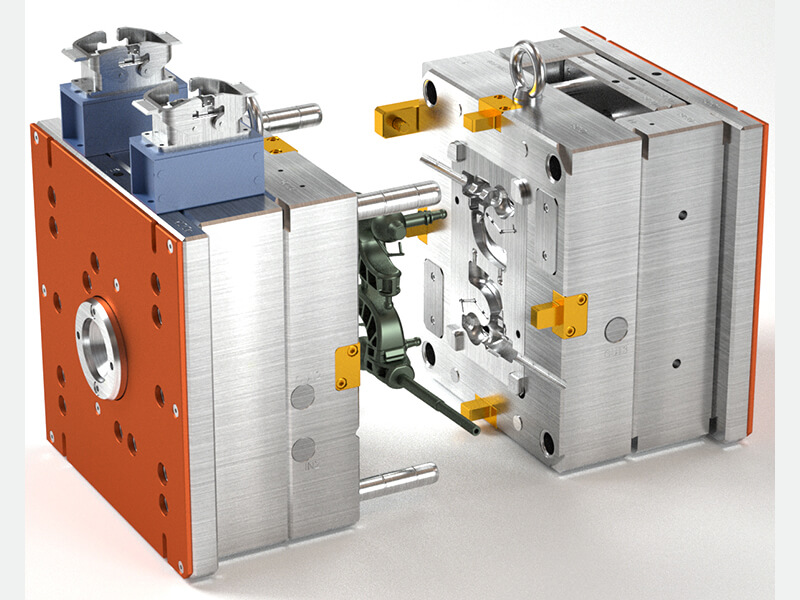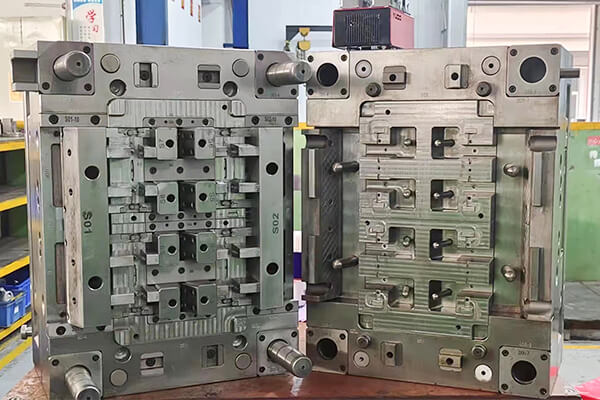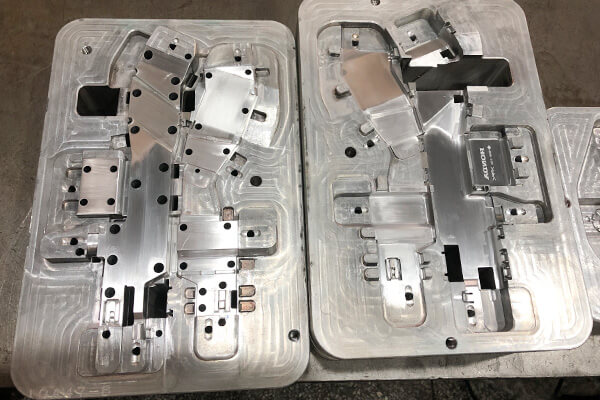Mold Manufacturing: Used for Injection Molded Parts
At Sungplastic, mold manufacturing is a quite mature process. With our numerous injection molded parts production experience, our customers are very pleased with result of their projects.
If you don’t know mold manufacturing or injection molding process, read this one and you’ll get some guides.

Mold Manufacturing: a Key of Injection Molding Process
Injection molding stands as a widely employed manufacturing method for crafting plastic products. This process, in high demand, is adept at replicating identical parts in large quantities. Commencing with a Computer Aided Design (CAD) file containing a digital representation of the desired part, this file serves as a blueprint for the mold manufacturing. Typically, molds, or tools, are fashioned from two pieces of metal. Both mold halves incorporate a cavity mirroring the part’s shape. Materials of choice for mold manufacturing often encompass aluminum, steel, or their alloys, with Sungplastic exclusively employing high-quality steel and aluminum for all mold manufacturing.
Subsequent to mold manufacturing, the subsequent stride entails the selection of the appropriate plastic material. The chosen material hinges on the intended use of the final part and demands consideration of various plastic attributes. These encompass aspects like the overall appearance, texture, as well as resistance to chemicals, heat, and wear. For an in-depth exploration of available plastic materials for injection molding, consulting Sungplastic’s experts is highly recommended.
The chosen plastic material commences as small plastic pellets, which are introduced into a hopper integrated into the injection-molding machine. These pellets traverse a heated chamber, where they undergo melting, compression, and subsequent injection into the mold cavity. Upon cooling, the mold’s two halves part to expel the finished part. The machine then resets, ready to initiate the process anew.
Materials Used in Mold Manufacturing
Molds are fashioned using a selection of materials, namely steel, aluminum, or various alloys. At Sungplastic, a preference for high-quality steel is evident in their mold manufacturing. While the cost of steel mold manufacturing tends to be somewhat higher compared to aluminum or alloy alternatives, this expense is often justified by the considerably extended lifespan offered by steel molds. In contrast, aluminum molds, though more cost-effective to create initially, suffer from a shorter operational life and necessitate frequent replacement.
Steel molds, renowned for their durability, typically endure well beyond one hundred thousand operational cycles, making them a robust and cost-effective choice in the long run. Furthermore, steel molds facilitate the realization of intricate and complex designs that may be unattainable with aluminum counterparts. The added advantage of steel molds lies in their repairability and adaptability through welding, sparing the need for a complete overhaul in case of damage or design modifications. In contrast, aluminum molds necessitate entirely new machining in such scenarios. The premium quality of steel molds empowers them to withstand thousands, hundreds of thousands, and sometimes even up to a million operational cycles, showcasing their remarkable longevity.


Components of Injection Molds
Injection molds generally consist of two primary parts: an A side (cavity) and a B side (core). The cavity side typically represents the higher-quality surface, while the core side may exhibit some visual imperfections due to the presence of ejector pins responsible for pushing the finished part out of the mold. In addition to these mold core components, an injection mold incorporates various supporting elements, including support plates, an ejector box, an ejector bar, ejector pins, ejector plates, a sprue bushing, and a locating ring.
Injection molding is a complex manufacturing process with multiple interrelated components. Here is a breakdown of key terms that describe the essential elements involved in mold manufacturing and injection molding. The tooling comprises numerous steel plates organized within a frame, which is inserted into the injection-molding machine and secured with clamps. A cross-sectional view of an injection mold resembles a layered sandwich. For a comprehensive list of terminology, refer to our Injection Molding Glossary.
Mold Frame or Mold Base
A series of steel plates that holds all mold components together, including cavities, cores, runner systems, cooling systems, and ejection systems.
A Plate
One half of the metal mold that does not contain moving parts and can hold either the cavity or core.
B Plate
The other half of the metal mold, which contains moving parts or space for moving parts, typically housing the ejector pins.
Support Plates
Steel plates within the mold frame that provide structural stability during the molding process.
Ejector Box
Houses the ejector system responsible for pushing the finished part out of the mold.
Ejector Plates
Steel plates that contain the ejector bar; they move to eject the finished product after molding.
Ejector Bar
Part of the ejector plate to which the ejector pins are connected.
Ejector Pins
Steel pins that come into contact with the finished part, pushing it out of the mold; their marks may be visible on some injection-molded items.
Sprue Bushing
Connects the mold to the injection-molding machine, serving as the entry point for molten resin into the cavity.
Sprue
The location on the mold frame where molten resin enters the mold cavity.
Locator Ring
A metal ring ensuring proper alignment of the injection-molding machine’s nozzle with the sprue bushing.
Cavity or Die Cavity
The concave impression in the mold, typically forming the outer surface of the molded part, with molds categorized as single or multi-cavity based on the number of depressions.
Core
The convex impression in the mold, forming the inner surface of the molded part and constituting a raised section. Molten resin is introduced into the cavity, filling the space around the raised core.
Runner or Runner System
Channels within the metal mold that facilitate the flow of molten resin from the sprue to the cavity or between cavities.
Gate
The entry point of melted resin into the mold cavity, with various gate designs available for different applications, such as pin, spoke, fan, edge, disk, tunnel, banana, cashew, and chisel gates. Gate design and placement are crucial considerations in mold manufacturing.
Cooling System
A network of channels on the mold’s outer shell, circulating a cooling fluid to facilitate proper cooling. Efficient cooling is essential to prevent surface and structural defects in molded parts, with cooling typically comprising a significant portion of the injection molding cycle. Fathom offers Conformal Cooling for many injection-molding applications, increasing mold efficiency by up to 60%.
Mold Manufacturing for Diverse Molding Processes
The plastic injection molding process is remarkably adaptable, catering to a wide array of intricate requirements. While it excels in high-volume production of uncomplicated plastic components, it also exhibits the versatility to produce highly complex parts with intricate geometries or intricate assemblies.
Multi-Cavity or Family Mold
This mold configuration features multiple cavities within a single mold frame, yielding several identical or related parts in each injection cycle. It proves ideal for scaling up production volumes and driving down the per-piece cost.
Overmolding
Employed for crafting parts composed of two distinct plastic types, such as a handheld drill body or a game controller with a rigid outer shell and soft, rubberized grips. In this process, a pre-molded component is placed into a specially designed mold, which is then closed as a different plastic layer is injected over the initial part. This technique shines when the goal is to achieve contrasting textures.
Insert Molding
An injection molding approach that allows for the integration of metal, ceramic, or plastic elements into the final product. Metal or ceramic components are positioned within the mold, and molten plastic is subsequently injected to seamlessly fuse two different materials. Insert molding finds favor in automotive applications, offering an innovative avenue to reduce weight and minimize the use of costly materials like metal, preserving metal only for connecting portions while the rest of the item is formed from plastic.
Co-Injection Molding
In this method, two distinct polymers are introduced sequentially or simultaneously into a mold cavity. This process results in parts with one type of plastic forming the exterior skin and another comprising the core.
Thin-Wall Molding
Tailored for efficiency, this form of injection molding prioritizes shorter cycle times and enhanced productivity to craft thin, lightweight, and cost-effective plastic components.
Rubber Injection
Mirroring the principles of plastic injection molding, this technique involves injecting rubber into a mold. Rubber parts necessitate higher injection pressures for successful molding.
Ceramic Injection
Employing ceramic material in the injection molding process. Ceramic, known for its natural hardness and chemical inertness, serves various industries. Ceramic injection entails additional steps, including sintering or curing the newly molded parts, ensuring the characteristic durability of ceramic components.
Low-Pressure Plastic Injection Molding
Crafted for the production of plastic components under lower injection pressures. This method proves particularly valuable for applications requiring the encapsulation of delicate parts, such as electronics, where gentler molding conditions are imperative.
Sungplastic: Mold Manufacturing Solution for You
Our mold manufacturing solution includes but not limited:
Prototype mold fabrication
Rapid tooling
Thermoforming tooling
Custom Mold for mini precision parts
Custom Mold for complex injection molded parts
If you are looking for a reliable mold manufacturer, Sungplastic will be your best choice.
Get a free quote and design analysis today.
We’ll reply to you within 6 working hours.
We respect your privacy.
+86 139 2927 4777 (WhatsApp, Wechat)
